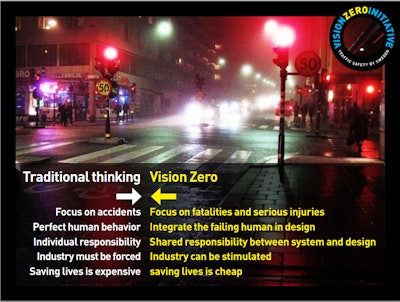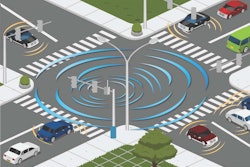Goals need to be attainable – that’s an early business management lesson. So is it preposterous to imagine zero traffic fatalities in the U.S.? Most of us would shrug and say the target is impossible to hit. That’s doesn’t mean the trucking industry won’t keep trying.
Better still, trucking should lead this parade. Imagine the benefits – social, political, economic – if the entire industry was elevated to the rank of highway hero, rather than just a very, very few of our self-promoted best and bravest.
A tweet from the National Transportation Safety Board got me to thinking (uh-oh).
The NTSB goal is to get to zero deaths. Each substance-impaired crash is preventable. #druggeddriving
— NTSB (@NTSB) December 18, 2013
The message was part of a recent Twitter forum tagged #druggeddriving.
(NTSB issued a report last spring, Reaching Zero: Actions to Eliminate Alcohol-Impaired Driving, which calls for lowering the blood alcohol concentration limit and for the use in-vehicle prevention technology, among other things).
So how about reducing all traffic deaths by 50 percent? Or by “only” 20?
Now we’re likely getting somewhere, and the easy part is this: The first steps on that long journey to zero fatalities have already been mapped, successfully, elsewhere.
 The Vision Zero plan calls for rethinking vehicle safety.
The Vision Zero plan calls for rethinking vehicle safety.In Sweden, the Vision Zero concept hinges on the notion that no loss of life is acceptable. The approach, which has greatly reduced fatalities even as traffic has increased, “is based on the simple fact that we are human and make mistakes. The road system needs to keep us moving. But it must also be designed to protect us at every turn.”
I happened to speak with Alan Korn, director of advanced brake system integration at Meritor WABCO, after the Twitter forum. We were scheduled to discuss some really interesting developments in vehicle-to-vehicle communications (more to come), but as it turned out, Korn has a passion for the notion of zero traffic fatalities.
He admits, as an engineer, to some initial skepticism. He recalls being part of the program at a Lifesavers conference where Vision Zero was discussed.
“Does it really make sense to set an objective that you’re just not going to achieve?” Korn says. “Everyone talks about establishing measureable, achievable objectives. You want to have stretch goals, but you don’t want to have a situation where you know going in you’re never going to achieve that objective.”
Then he faced a very straightforward rebuttal from a safety advocate at the conference: “What if your loved one is the one fatality?”
So, even a very objective, analytical mind should be willing to open up a little.
“Obviously, everyone thinks it’s a great goal,” he says. “Like everything else, it’s going to have to be done gradually. One way of doing it is to set realistic goals.”
He cites the seemingly bold goal set by then-Transportation Secretary Rodney Slater in 1999 to reduce truck-related fatalities by 50 percent over the next decade.
“What was so good about that was the trucking industry achieved it, and then some,” if the data is normalized for miles driven, he says. “I think we have to document the next goal that we can measure and track.”
The good news for trucking, right off the bat, is that #druggeddriving/DUI is already a zero-tolerance area for the industry. A Vigillo analysis puts controlled substances/alcohol at less than one-tenth of one percent of SMS reported violations last year, and trucking companies themselves are asking for regulatory approval of more stringent hair testing in driver drug screens.
That puts trucking way ahead of the general public already.
“These are things that could be corrected overnight,” Korn says. “How many fatalities could be eliminated if we just found a way to prevent impaired driving.”
Noting the research that indicates automobile drivers are at fault in about three out of four truck-involved fatal accidents, another obvious target would be to better educate light-vehicle drivers on driving around tractor-trailers, Korn suggests.
Related: Next-generation driver training technologies
He’s in the business of building better trucks, of course, and he’s optimistic that carriers will continue to invest in safety technology.
“One thing I really like about the trucking industry is that it realizes safety pays. The trucking industry very clearly embraces the fact that if safety improves, business improves,” Korn says. “If you look at what trucking is doing with higher level technology, it’s very, very impressive. They should be very proud.”
He cites the market penetration of stability control technology, at about 50 percent, as an example of a safety investment that “ultimately is going to improve the bottom line.”
More subtly, vehicle safety technologies “promote a more conservative style of driving,” he notes – meaning slower speeds, greater following distances and the like. And that style of driving affords both cars and trucks a little more room for error in potential accident situations.
The Vision Zero program also calls for a redesign of the transportation system with a focus on preventing serious crashes, but Korn is less hopeful about achieving significant infrastructure improvements anytime soon.
“Everyone has these great ideas, but no one has found a way to pay for them,” he says. “I’m just not sure that’s in the cards right now. We can’t seem to find enough money to repair what we have to today, let alone make major investments.”
And the latest National Highway Traffic Safety Administration crash statistics, with increases in crash rates and fatalities, are “disappointing” and “intolerable.”
Related: NHTSA data shows fatalities on the rise
“I feel strongly on zero fatalities. We’re losing close to 90 people a day. Something really has to be done – and we don’t have to wait 20 years for autonomous vehicles,” he says, referring to the much-discussed potential of self-driving cars and trucks. “We could do things tomorrow. Let’s do something in 2014!”
Do let’s. Who else has ideas? Feel free to comment here, or send me an email.













